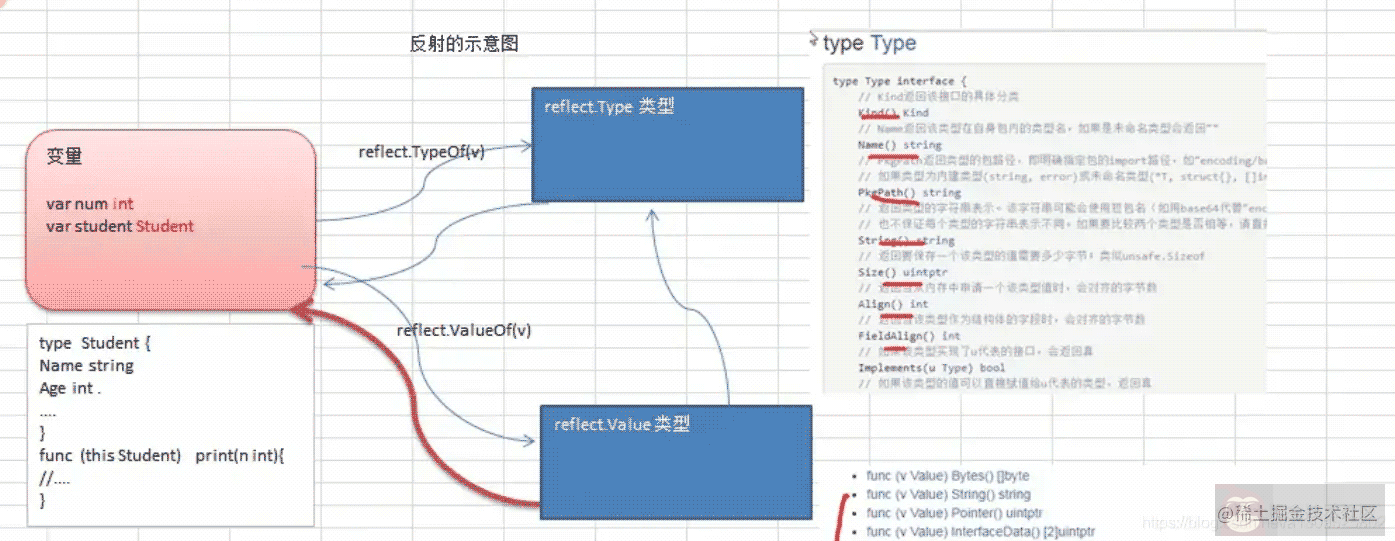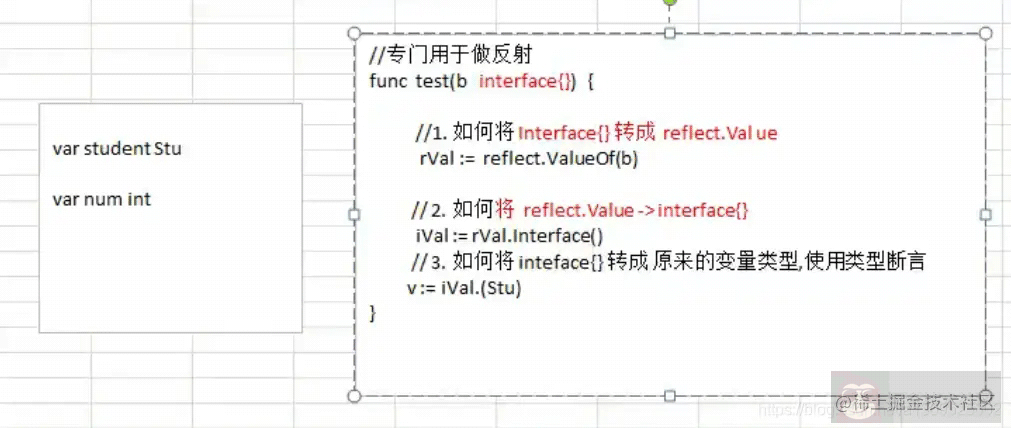共计 2601 个字符,预计需要花费 7 分钟才能阅读完成。
| 导读 | 这篇文章主要为大家介绍了 Go 语言开发框架反射机制及常见函数示例详解,有需要的朋友可以借鉴参考下,希望能够有所帮助,祝大家多多进步,早日升职加薪 |
基本介绍
示意图

反射中常见函数和概念
reflect.TypeOf(变量名)
获取变量的类型, 返回 reflect.Type 类型
reflect.ValueOf(变量名)
获取变量的值, 返回 reflect.Value 类型 reflect.Value 是一个结构体类型, 通过 reflect.Value, 可以获取到关于该变量的很多信息
变量.interface{} 和 reflect.Value 是可以相互转换的

基本使用
| package main | |
| import ( | |
| "fmt" | |
| "reflect" | |
| ) | |
| /* | |
| 1. 编写案例, 对基本数据类型,interface{},reflect.Value 进行反射 | |
| 2. 编写案例, 对结构体,interface{},reflect.Value 进行反射 | |
| */ | |
| func reflectTest(b interface{}){ | |
| // 打印出传参的 type,kind,value | |
| fmt.Printf("b 的类型为 %v,b 的 kind 为 %v,value 为 %v\n",reflect.TypeOf(b),reflect.ValueOf(b).Kind(),reflect.ValueOf(b)) // b 的类型为 int,b 的 kind 为 int,value 为 100 | |
| //reflect.TypeOf(),reflect.ValueOf() 返回的类型 | |
| fmt.Printf("reflect.TypeOf() 返回类型为 %T,reflect.ValueOf() 返回类型为 %T\n",reflect.TypeOf(b),reflect.ValueOf(b)) //reflect.TypeOf() 返回类型为 *reflect.rtype,reflect.ValueOf() 返回类型为 reflect.Value | |
| } | |
| type Student struct { | |
| Name string | |
| age int | |
| } | |
| func reflectTest2(b interface{}){rTyp:=reflect.TypeOf(b) | |
| fmt.Println(rTyp) //main.Student | |
| rVal:=reflect.ValueOf(b) | |
| // 将 rVal 转换成 interface{} | |
| iV:=rVal.Interface() | |
| fmt.Printf("iv=%v type=%T\n",iV,iV) //iv={张三 18} type=main.Student | |
| // 因为 Go 语言是静态语言, 所以不能直接获取结构体中指定的值, 所以我需要将其断言成需要的类型 | |
| stu,ok:=iV.(Student) | |
| if ok{fmt.Printf(stu.Name,stu.age) // 张三 %!(EXTRA int=18) | |
| } | |
| } | |
| func main() {//1. 编写案例, 对基本数据类型,interface{},reflect.Value 进行反射 | |
| var num int =100 | |
| reflectTest(num) | |
| //2. 编写案例, 对结构体,interface{},reflect.Value 进行反射 | |
| stu:=Student{ | |
| Name: "张三", | |
| age: 18, | |
| } | |
| reflectTest2(stu) | |
| } |
反射注意事项
反射的最佳实践
使用反射来遍历结构体的字段, 调用结构体的方法, 并获取结构体标签的值
| package main | |
| import ( | |
| "fmt" | |
| "reflect" | |
| ) | |
| // 定义了一个 Monster 结构体 | |
| type Monster struct { | |
| Name string `json:"name"` | |
| Age int `json:"monster_age"` | |
| Score float32 `json:"成绩"` | |
| Sex string | |
| } | |
| // 方法,返回两个数的和 | |
| func (s Monster) GetSum(n1, n2 int) int {return n1 + n2} | |
| // 方法,接收四个值,给 s 赋值 | |
| func (s Monster) Set(name string, age int, score float32, sex string) { | |
| s.Name = name | |
| s.Age = age | |
| s.Score = score | |
| s.Sex = sex | |
| } | |
| // 方法,显示 s 的值 | |
| func (s Monster) Print() {fmt.Println("---start~----") | |
| fmt.Println(s) | |
| fmt.Println("---end~----") | |
| } | |
| func TestStruct(a interface{}) { | |
| // 获取 reflect.Type 类型 | |
| typ := reflect.TypeOf(a) | |
| // 获取 reflect.Value 类型 | |
| val := reflect.ValueOf(a) | |
| // 获取到 a 对应的类别 | |
| kd := val.Kind() | |
| // 如果传入的不是 struct,就退出 | |
| if kd != reflect.Struct {fmt.Println("expect struct") | |
| return | |
| } | |
| // 获取到该结构体有几个字段 | |
| num := val.NumField() | |
| fmt.Printf("struct has %d fields\n", num) //4 | |
| // 变量结构体的所有字段 | |
| for i := 0; i | |
| 以上就是 Go 语言开发框架反射机制及常见函数示例详解的详细内容 | |
| 阿里云 2 核 2G 服务器 3M 带宽 61 元 1 年,有高配 | |
| 腾讯云新客低至 82 元 / 年,老客户 99 元 / 年 | |
| 代金券:在阿里云专用满减优惠券 |
正文完
星哥玩云-微信公众号
















